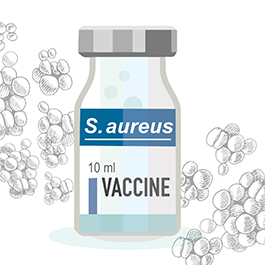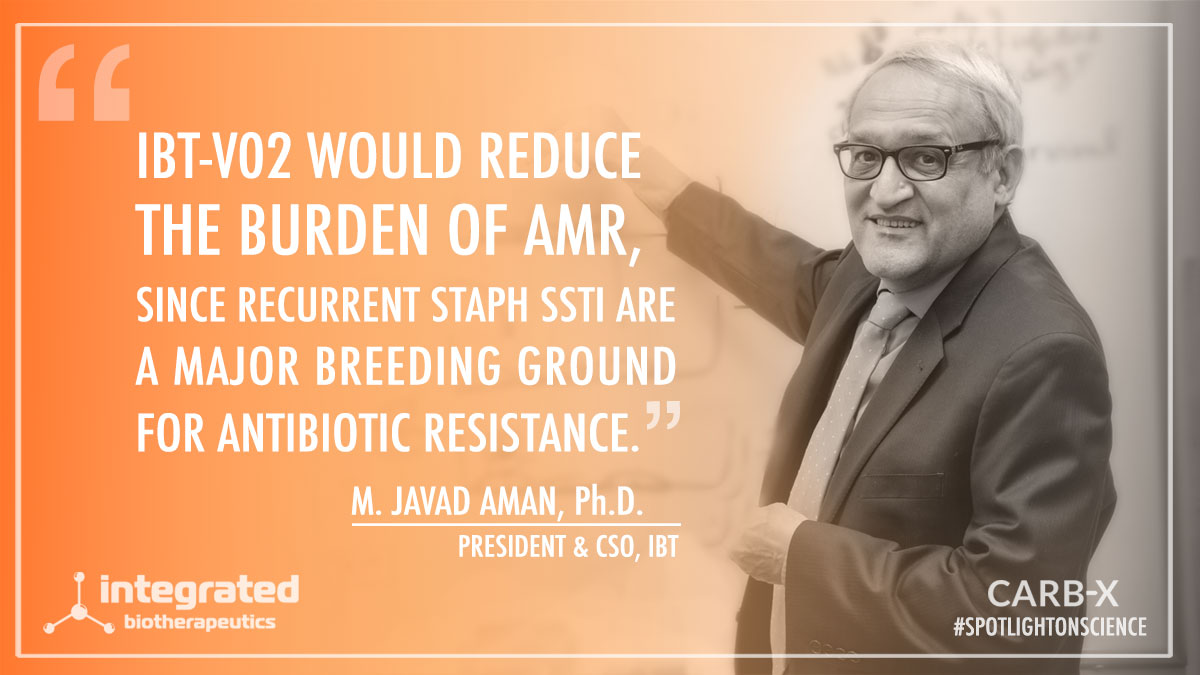
Integrated BioTherapeutics, Rockville, MD, USA
www.integratedbiotherapeutics.com
Integrated BioTherapeutics’ toxin-targeted Staphylococcus aureus vaccine leverages a decade of hard-earned learnings
By Nadia Cohen
Integrated BioTherapeutics (IBT) has a fresh take on how to achieve an effective vaccine against Staphylococcus aureus, a problem that has both tantalized and frustrated vaccine developers. In 2017, IBT entered the CARB-X portfolio as CARB-X’s first vaccine developer. The small, Maryland-based company is leveraging a decade of new research on the pathogenesis and epidemiology of the organism, and betting that targeting toxins might be the answer.
S. aureus is a leading cause of human infection. It often targets the skin, but can also attack the heart, bones, lungs and joints. Invasive forms of disease in which the bacteria enter the bloodstream can lead to sepsis and death. S. aureus is an important cause of neonatal sepsis and death in neonates. Globally, drug-resistant S. aureus strains are a growing concern, with S. aureus recognized to be the second leading pathogen for deaths associated with resistance, according to a recent Lancet study. Methicillin-resistant S. aureus (MRSA) superbugs are now responsible for approximately 50% of staphylococcal infections which the Lancet study estimated to cause in excess of 100,000 deaths in 2019 alone. Resistance to other antibiotics has also emerged, and the World Health Organization now lists S. aureus as a “high priority” pathogen for new antibiotic development.
The high burden of S. aureus disease and blockbuster success of vaccines against other bacteria–such as S. pneumoniae in the early 2000s–led pharmaceutical companies to invest heavily in this space. Initially, researchers hypothesized that antibodies raised against the bacterial surface would protect against infection, since immune cells can more readily ingest bacteria cloaked in antibodies. Buoyed by the compelling efficacy of candidate S. aureus vaccines in mice and the successful generation of surface-targeted antibodies in early human testing, developers embarked on ambitious clinical trials to demonstrate protection in humans. Unfortunately, these early and costly efforts did not succeed.

IBT scientists setting up an experiment. Photo courtesy of IBT
In the reckoning that followed, the mechanisms behind S. aureus’ ability to cause disease were probed, and a key role emerged for two families of S. aureus toxins: pore-forming toxins (PFTs) and superantigens (SAgs). Bacteria isolated from sick patients were found to be much more likely to secrete toxins than those taken from the skin of healthy people. “The field also began to better define how bacteria use these toxins to breach biological barriers,” explains Dr. M. Javad Aman, IBT Founder, President and Chief Scientific Officer. “They kill red blood cells to extract iron, causing platelet aggregation that can lead to multiorgan failure; disarm the innate immune system by killing cells of the first line of defense; and intoxicate the T cells to prevent effective memory T cell responses.” It became increasingly clear that the impact of toxins in humans was different than in rodents. Mice and rats are much less sensitive to the effects of these toxins, which might explain why early vaccine programs relying only on rodent models did not translate. Antibodies against the bacterial surface may protect mice, in which the role of toxins is less prominent, but may not prevent human toxin-driven disease.
Dr. Aman is no stranger to toxins. Before creating IBT, he led a research group at the US Army Medical Research Institute of Infectious Diseases focused on biodefense countermeasures against microbial toxin attacks. A powerful S. aureus toxin called SEB was a focus of his research. While SEB had been weaponized, it was never deployed in warfare. “From the beginning, I was really struck by how potent these toxins are, and when I founded IBT, one of the first programs I started was looking for a toxoid-based vaccine that could protect warriors.”
These efforts eventually morphed into IBT-V02, the vaccine candidate that Dr. Aman and his team are now preparing for initial human testing. IBT-V02 contains the components of three pore-forming toxins mutated to be harmless. These include alpha-hemolysin (Hla), Panton-Valentine leukocidin (PVL) subunits LukS and LukF, and leukocidin A/B (LukAB). IBT-V02 also contains fusion toxoid TBA225 with key elements of three SAg toxins–SEA, SEB and TSST-1. To determine whether the vaccine might work in humans, the IBT team has, among other experiments, tested the ability of serum from vaccinated animals to prevent S. aureus toxins from harming human or rabbit cells in vitro. “What we see is that antibodies appear that not only neutralize all the toxins represented in the vaccine, which are key, but also a number of related ones, which is very exciting,” says Dr. Aman.
Animals immunized with IBT-V02 are protected against skin and soft tissue infections (SSTI), including pyomyositis–a deep muscle infection common in developing nations–as well as more invasive forms of pneumonia and bacteremia. The IBT team has demonstrated their vaccine is effective not only in mice, but also in rabbits, which are inherently much more sensitive to staphylococcal toxins than rodents. If these findings hold true in the clinic, IBT-V02 could be a very valuable tool against a range of human staphylococcal infections.

M. Javad Aman, IBT’s President and Chief Scientific Officer. Photo courtesy of IBT
While IBT-V02 must be tested to demonstrate protection against human disease, data from other human studies suggest that antitoxin antibodies can indeed be protective. Because S. aureus is so common, many of us have some level of pre-existing antibodies against the bacteria, but the quantity and quality of these antibodies are highly variable and they are not reliably protective. A key 2013 study demonstrated that children with high baseline levels of antibodies against Hla and PVL, for instance, are less likely to develop severe invasive disease following infection, and that the level of Hla antibodies correlates with a reduced risk of recurrence. Studies conducted around the same time found lower risks of sepsis in adults with antitoxin antibodies. The protective effect of SAg neutralizing antibodies against menstrual toxic shock syndrome, a rare but life-threatening form of staphylococcal disease, has been known since the 1980s. “There are no studies published showing that if you have a high level of opsonophagocytic [surface-targeted] antibodies, you are less likely to get an infection or unfavorable clinical outcome,” says Dr. Aman. “Those studies exist only for toxin-neutralizing antibodies.”
IBT’s clinical plan could help determine the efficacy of IBT-V02 relatively rapidly. Several earlier efforts focused on preventing post-elective surgery infections, for which the market in high-income countries is significant. But as devastating as these infections are, they are also relatively infrequent, meaning that trials must enroll tens of thousands of subjects, most of whom will never become infected, in order to establish vaccine efficacy.
“IBT’s clinical approach is to achieve rapid clinical proof of concept in recurrent skin and soft tissue infections (SSTI) as the initial indication for market entry,” says Dr. Aman. “SSTIs are very important in terms of public health. They account for the vast majority of S. aureus infections, and in terms of antimicrobial resistance, SSTIs are really the breeding ground. But also, from a pure practicality, the time and cost to proof of concept is fairly low.” Dr. Aman estimates that the cost of IBT-V02 clinical work could be close to tenfold less than what was spent in earlier failed efforts. Once the vaccine has shown efficacy in this setting, the plan would be to expand testing to rarer life-threatening indications.
“Resistance development relentlessly continues to threaten existing methods of treatment for staphylococcal infections,” says Erin Duffy, PhD, CARB-X Chief of R&D. “Given the global prevalence of S. aureus infections, an effective vaccine has the potential for a very significant impact on morbidity and mortality associated with staphylococcal diseases, but also broadly on antibiotic consumption and the development of AMR. IBT-VO2 represents an educated, innovative and highly differentiated approach to the development of such a vaccine.”
IBT has recently initiated a Series A funding round to help support Phase I and Phase II studies for IBT-V02. Discovery of IBT-V02 components was largely funded by NIAID, and since 2017, IBT has received close to US$18M in non-dilutive funding from CARB-X and $3.9M from Novo Holdings to advance their candidate through pre-clinical development. Novo Holdings REPAIR Impact Fund has committed to acting as a major strategic investor. In addition to Series A, IBT will apply for further non-dilutive CARB-X funds to support early clinical work, which is slated to begin in late 2022.

M. Javad Aman, IBT’s President and Chief Scientific Officer. Photo courtesy of IBT
M. Javad Aman
President and Chief Scientific Officer
Prior to his work at IBT, Javad Aman ran a research laboratory at the US Army Medical Research Institute of Infectious Diseases (USAMRIID) where he focused on development of vaccines for staphylococcal toxins and viral glycoproteins. He received his master’s degree in pharmacy at Wolfgang Goethe University in Frankfurt, Germany, and a PhD in molecular immunology at the Johannes Gutenberg University Mainz, Germany and completed his postdoctoral training at the US National Institutes of Health and the University of Virginia. Dr. Aman has published more than 125 peer-reviewed scientific papers in reputable international journals.
For more information, www.integratedbiotherapeutics.com
Published on February 22, 2022


